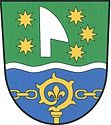Horní Studénky
| Horní Studénky | ||||
|---|---|---|---|---|
|
||||
| Basic data | ||||
| State : |
|
|||
| Region : | Olomoucký kraj | |||
| District : | Šumperk | |||
| Area : | 724 ha | |||
| Geographic location : | 49 ° 57 ' N , 16 ° 49' E | |||
| Height: | 515 m nm | |||
| Residents : | 339 (Jan 1, 2019) | |||
| Postal code : | 789 01 | |||
| License plate : | M. | |||
| traffic | ||||
| Street: | Štíty - Rovensko | |||
| structure | ||||
| Status: | local community | |||
| Districts: | 1 | |||
| administration | ||||
| Mayor : | Jaromír Minář (as of 2009) | |||
| Address: | Horní Studénky 44 789 01 Zábřeh |
|||
| Municipality number: | 535770 | |||
| Website : | hornistudenky.cz | |||
Horní Studénky (German Studinke ) is a municipality in the Czech Republic . It is located three kilometers east of Štíty and belongs to the Okres Šumperk .
geography
Horní Studénky extends in a basin in the Drozdovská vrchovina ( Drosenauer Uplands ). The village is located in the Březná Nature Park. The Nemilka rises in Horní Studénky. To the north rises the Pustina (626 m), in the east the Rozsocha (518 m), southeast the Háječek (603 m), in the west the Obora (585 m) and to the northwest the Králova hora ( Königsberg , 602 m). In the northwest is the Sychrov pond.
Neighboring towns are Jakubovice and Bušín in the north, Na Horách and Olšany in the northeast, Klášterec in the east, Zborov and Svébohov in the southeast, Na Dole and Jedlí in the south, U Mlýna and Crhov in the southwest, Na Kluči and Štíty in the west, and Březná and Bukovice in the Northwest.
history
Studenky was first mentioned in writing in 1353. The village is said to have been named as Odendorf and in Latin Deserta villa as early as 1350 ; other sources, which are also unconfirmed, speak of Bohemicalis villa . There is evidence of a church in Studenky since 1531 . This was the destination of Leonhard's pilgrimages since 1620 . In the years 1666–1672 the wooden church was replaced by a new building. A school has existed in Studenky since 1786. Two years later the rectory was built.
After the abolition of patrimonial Studenky / Studinke formed from 1850 a political municipality in the Hohenstadt district and the Schildberg judicial district . Because of its mountain location, agriculture was not very productive, so that the residents earned extra income by working at home with the production of twisted heads, brushes and wooden goods as well as basket weaving and broom making. In 1908 a new school building was built. In 1930 Studenky had 656 inhabitants.
After the Munich Agreement , the village, which was largely inhabited by Czechs, was added to the German Reich in 1938 and belonged to the Hohenstadt district until 1945 . In the Sudeten German elections to the Reichstag in December 1938, Studinke was one of the few villages in which the majority of voters voted against the NSDAP candidates. In 1939, 726 people lived in Studinke. During the time of the occupation, the St. Leonhard pilgrimage in Studinke developed into a national manifestation of the Czechs in the Third Reich. The Troppau district president Friedrich Zippelius saw a demonstration under the guise of the church in the pilgrimage in 1941 and Reich Governor Konrad Henlein then banned the pilgrimage.
After the end of the Second World War, Horní Studénky came back to Czechoslovakia. Some of the residents left the place and settled in the border areas . In 1958 the community had 503 inhabitants. After the dissolution of the Okres Zábřeh Horní Studénky was assigned to the Okres Šumperk at the beginning of 1961 . Between 1985 and 1990 the place was incorporated into Štíty .
Community structure
No districts are shown for the municipality of Horní Studénky. The Na Horách settlement belongs to Horní Studénky.
Attractions
- Pilgrimage church of St. Leonhard, the renaissance building was built between 1666 and 1672 instead of a previous wooden building that has been documented since 1531
- Churchyard wall from the 16th century, the cloister was laid out in 1734
- Chapel, 18th century
Sons and daughters of the church
- Čeněk Rýznar (1845–1923), doctor and archaeologist
- Vladimír Přikryl (1893–1968), major general


